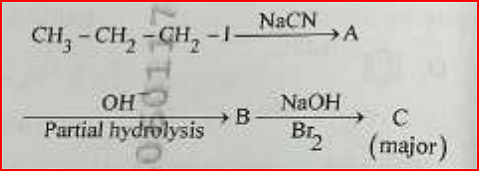The reaction in which $2$ molecules of chlorobenzene reacts with metallic sodium in presence of dry ether forming diphenyl is an example of,
- Wurtz-Fittig reaction
- Wurtz reaction
- Rosenmund reaction
- Balz-Schiemann reaction
The Correct Option is A
Solution and Explanation

Top Questions on Chemical Reactions
- For given reaction:

‘P’ is- NEET (UG) - 2024
- Chemistry
- Chemical Reactions
- Identify the correct reagents that would bring about the following transformation.


- NEET (UG) - 2024
- Chemistry
- Chemical Reactions
- The rate of a reaction quadruples when temperature changes from 27°c to 57°c. Calculate the energy of activation
Given R=8.314 J K-1 mol-1, log 4=0.6021- NEET (UG) - 2024
- Chemistry
- Chemical Reactions
- Identify the major product C formed in the following reaction sequence:

- NEET (UG) - 2024
- Chemistry
- Chemical Reactions
- The products A and B obtained int he following reactions, respectively, are
3ROH+PCI3→3RCI+A
ROH+PCI5→RCI+HCI+B- NEET (UG) - 2024
- Chemistry
- Chemical Reactions
Questions Asked in MHT CET exam
- Two monkeys off mass 10 kg and 8 kg are moving along a vertical light rope the former climbing up with an acceleration of 2 m/second square while the latter coming down with a uniform velocity of 2 m/sec square find the tension in the rope at the fixed support
- MHT CET - 2024
- tension
- Total genetic content of an organism is called
- MHT CET - 2024
- Non-Mendelian Genetics
- How many ATP molecules are needed as an initial investment in the glycolytic cycle (normal glycolysis)?
- MHT CET - 2024
- Glycolysis
- Which disease is primarily spread by female Anopheles mosquitoes?
- MHT CET - 2024
- HIV and AIDS
- If \(A=\begin{bmatrix} 2a & -3b\\ 3 & 2\end{bmatrix}\) and \(\text{adj}A = AA^T\), then 2a+3b is?
- MHT CET - 2023
- Matrices
MHT CET Notification
 MHT CET 2024 CAP Round 2 Seat Allotment Out, Direct Link here.Aug 26, 2024
MHT CET 2024 CAP Round 2 Seat Allotment Out, Direct Link here.Aug 26, 2024Concepts Used:
Haloalkanes and Haloarenes - Chemical Reactions
Chemical Reactions go with the breaking and bonding of covalent bonds which involve of exchange of electrons. The functional groups of Organic compounds play a consequential role in the process. Based on the above theory, reactions can be classified into five main groups:
Rearrangement Reactions are the type of reactions in which products get formed simply by the rearrangement of atoms and electrons in the reactant molecules.
O
||
NH4CNO → NH2 –C – NH2
Substitution Reactions are the reactions in which an atom or group of atoms is replaced by some other atom or group of atoms without any change in the structure of the remaining part of the molecule.
CH3Br + KOH (aqueous) → CH3OH + KBr
Addition Reactions are the reactions in which products get formed by the addition of some reagent to an unsaturated compound.
CH2 = CH2 + HCl → CH5Cl
- Electrophilic Addition Reactions
- Nucleophilic Addition Reactions
- Free Radical Addition Reactions
Elimination Reactions are the reactions in which the products get formed by the loss of simple molecules like HX from the reactant molecules.
C2H5OH → C2H4
- EN1 (Nucleophilic Elimination Unimolecular)
- EN2 (Nucleophilic Elimination Bimolecular)
A polymerization Reaction is the union of two or more molecules of a substance that form a single molecule with higher molecular weight.
n (CH = CH2) → (-CH2 – CH2 -) n



